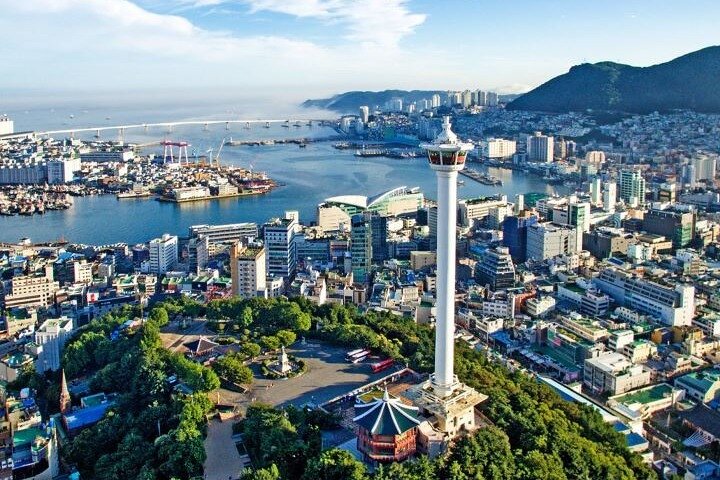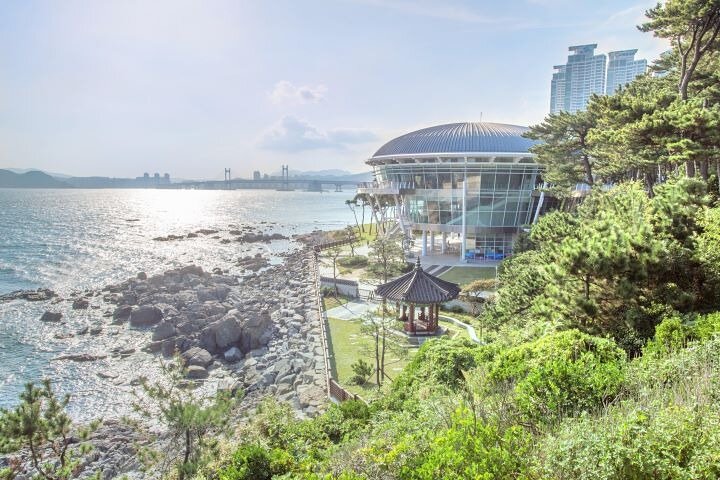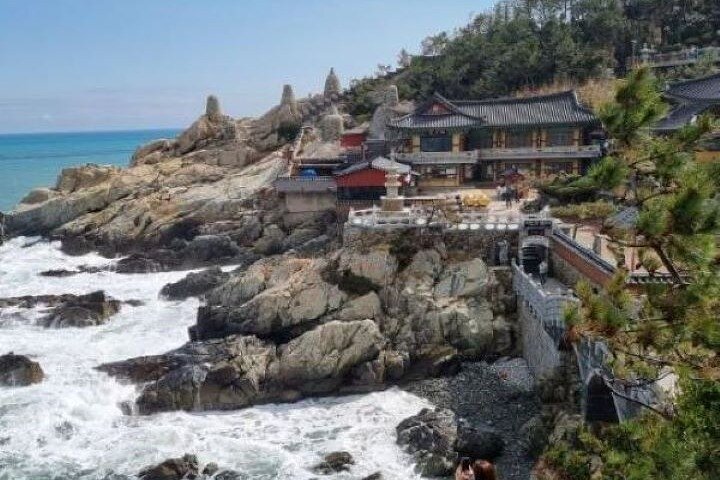Embark on a 4-day private tour of Busan, Gyeongju, and Geoje Island to discover the rich history, vibrant culture, and breathtaking natural beauty of South Korea. Explore ancient tombs, visit filming locations, and indulge in local cuisine on this unforgettable journey.
Embark on a 4-day private tour of Busan, Gyeongju, and Geoje Island to discover the rich history, vibrant culture, and breathtaking natural beauty of South Korea. Explore ancient tombs, visit filming locations, and indulge in local cuisine on this unforgettable journey.
Pick up at Busan / Gyeongju - Busan Hotel check-in or Gyeongju Hotel overnight
Haedong Yonggungsa Temple, Busan - Located on the northeastern coast of Busan, Haedong Yonggungsa Temple is a unique attraction as it is one of the few temples in Korea situated by the sea, with most being in the mountains. Established in 1376 by the esteemed Buddhist…
Pick up at Busan / Gyeongju - Busan Hotel check-in or Gyeongju Hotel overnight
Haedong Yonggungsa Temple, Busan - Located on the northeastern coast of Busan, Haedong Yonggungsa Temple is a unique attraction as it is one of the few temples in Korea situated by the sea, with most being in the mountains. Established in 1376 by the esteemed Buddhist teacher Naong during the Goryeo dynasty, the temple features the Seawater Great Goddess Buddha, Daeungjeon Main Sanctuary, Yongwangdang Shrine, Gulbeop Buddhist Sanctum (housed in a cave), and a three-story pagoda with four lions overlooking the ocean. Many visit on New Year’s Day to make wishes as the sun rises. April is particularly beautiful with cherry blossoms, and the temple is illuminated with lanterns during Buddha’s birthday in the fourth lunar month.
Daebyeon Port Entrance - Recognized as one of the 100 beautiful fishing villages by the Ministry of Oceans and Fisheries, Daebyeon Port hosts the anchovy festival, celebrating Gijang’s specialty. Anchovy Theme Square, the festival’s main venue, features iconic towers and stunning sculptures with lighting, music, and fountains. Visitors can enjoy abalone porridge, fresh seafood, and shop for dried seafood.
Haeundae Dalmaji-gil Road - Known as Busan’s Montmartre, Dalmaji-gil Road offers breathtaking views of the blue ocean, white sandy beach, Camellia forest, and pine trees, making it one of Busan’s eight scenic sites. Haeundae Dalmaji Hill and the moon viewed from Cheongsapo add to the area’s charm.
Songjeong Beach - Spanning 1.2 kilometers with a width of 30 to 60 meters, Songjeong Beach is perfect for families with young children due to its shallow waters. It’s a popular spot for pre-wedding photoshoots, and the surrounding area is known for its hoe (sliced raw fish) restaurants. Jukdo Park, located north of the beach, offers a scenic view from Songiljeong Pavilion and features white and red lighthouses popular for photography. Fishermen often gather along the breakwaters.
Haeundae Beach - As Busan’s most famous beach, Haeundae Beach stretches 1.5 kilometers with a width of 30 to 50 meters, creating a stunning coastline ideal for swimming. The area is bustling with visitors every summer, offering a range of accommodations from luxury hotels to guesthouses. Haeundae Beach is also known for its cultural events and festivals throughout the year. Nearby attractions include Dongbaekseom Island, Busan Aquarium, a yachting dock, BEXCO, and more.
Dongbaekseom - Dongbaekseom Island is renowned for its natural beauty, highlighted by dense camellia and pine trees. Nurimaru APEC House, a three-story building, serves as a memorial and international conference hall, showcasing a modern interpretation of traditional Korean architecture. The terrace offers views of Oryukdo Island, Gwangan Bridge, and Dallmaji Hill. Located near Haeundae Beach, it combines modern and natural beauty.
Shinsegae Centum City - Shinsegae Centum City Department Store, the world’s largest shopping complex according to Guinness World Records, offers a variety of entertainment options, including an ice rink, movie theater, golf range, and spa. It features 21 designer brands and 622 renowned brands. As Korea’s first department store, Shinsegae reflects decades of retail expertise. Designed by Italian architect Claudio Silvestrin and American firm Callison, Centum City embodies the concept of a “golden sea” and is a landmark in Busan.
UN Memorial Cemetery in Korea - The UN Memorial Cemetery in Korea honors UN soldiers from 16 countries and UN aids from five countries who died during the Korean War (1950-1953). It is the only cemetery dedicated to UN soldiers worldwide. Originally holding up to 11,000 graves, most soldiers were repatriated at their families’ request, leaving 2,300 graves. The serene park spans 135,000 square meters and features notable sites such as the Memorial Service Hall, Memorabilia Hall, Turkish Monuments, Greek Monument, Australian Monument, British Commonwealth Monument, and two ponds.
Oryukdo Skywalk - Oryukdo Island consists of Usakdo, Surido, Gonggotdo, Guldo, and Deungdaedo (Lighthouse) Islands. The upper part of Usakdo divides into two segments, leading to the names Bangpaedo and Sol Island, depending on water levels. As many ships pass by Oryukdo Island en route to Busan Port, it symbolizes Busan’s cultural heritage. The Oryukdo Skywalk, located at Seungdumal, offers stunning views and is a popular attraction.
Geoje Island Oedo Botania Garden - Busan Hotel check-in (All itineraries, flexible move or customized plan)
Geoga Grand Bridge - The “Geoga undersea tunnel and bridge” project began in early 2004, creating an 8.2km motorway between Busan and Geoje Island. The route includes a 4km immersed tunnel and two 2km cable-stayed bridges. The tunnel is expected to be one of the world’s longest, especially in a seismically active area. Opened on December 13, 2010, the Geoga Bridge connects Gadeok Island in Busan to Geoje Island, reducing the travel distance from 140 kilometers to 60 kilometers and travel time from 130 minutes to 50 minutes.
Hakdong Mongdol Beach - Hakdong Mongdol Beach, covered in small black pebbles, stretches 1.2 kilometers with a width of 50 meters, spanning 30,000 ㎡. Walking on the pebbles provides acupressure benefits. Unlike other southern beaches, Hakdong Mongdol Beach has deep waters and rough waves, but offers various water activities. Nearby accommodations and restaurants are available, and the beach’s dock offers boat excursions to popular attractions.
Windy Hill - On the way to Haegeumgang Village, visitors encounter the fishing village of Dojangpo. Dojangpo Wharf, on the village’s left, offers ferry tours to Oedo Island and Haegeumgang River. Overlooking the sea, Windy Hill is a grassy hill that gained popularity after being featured in Korean dramas like “Eve’s Garden (2003)” and “Merry-Go-Round (2004).” Visitors can enjoy views of Hakdong Village from the wooden promenade.
Sinseondae - Sinseondae Cliff
Sinseondae Observatory, located between Dojangpo Maeul and Haegeumgang, offers stunning views of uniquely shaped rocks against the deep-blue ocean. “Sinseon” means supernatural beings in Korean, and the spot’s beauty is said to attract them. The blue and yellow rock layers tell a unique geological story. A stairway from the road leads to the lookout point. Just past a gas station on the coastal highway, Sinseondae Observatory reveals itself. Walking on the rocks, visitors can enjoy views of surrounding islands and landscapes. Many commercials and TV shows have been filmed here. April and May are ideal for viewing bright-yellow canola flowers across the island.
Gyeongju - Busan Hotel check-in (All itineraries, flexible move or customized plan)
Bulguksa Temple - Bulguksa is a Buddhist temple complex featuring wooden buildings on raised stone terraces. The grounds are divided into three areas: Birojeon (Vairocana Buddha Hall), Daeungjeon (Hall of Great Enlightenment), and Geungnakjeon (Hall of Supreme Bliss). These areas and the stone terraces symbolize the land of Buddha. The stone terraces, bridges, and two pagodas – Seokgatap (Pagoda of Sakyamuni) and Dabotap (Pagoda of Bountiful Treasures) – facing Daeungjeon showcase the Silla’s masonry skills.
Daereungwon Tomb Complex - The Daereungwon Tomb Complex in Gyeongju features large ancient tombs of Silla Kingdom kings and nobles. It contains 23 large tombs, 13 of which have been excavated, but only one (Cheonmachong - tomb of King Michu) is open to the public. The tomb chamber held a lacquered wooden coffin surrounded by burial goods. A total of 11,500 artifacts were recovered, reflecting the king’s lavish lifestyle. Excavated in 1973, the tomb likely dates to the fifth century.
Gyeongju Folk Craft Village - Gyeongju Folk Craft Village consists of 40 thatched and tile-roofed houses inhabited by local artisans skilled in traditional arts and crafts. The village features various crafts, including metal, pottery, timber, jewels, hanbok (Korean traditional clothes), and stone crafts.
Gyeongju Gyochon Traditional Village - At Gyeongju Gyochon Village, visitors can explore the House of the Gyeongju Choi Clan (Important Folklore Material No. 27) and sample Gyeongju Gyodong Beopju Liquor (Important Intangible Cultural Asset No. 86-3). The village centers around the Gyeongju Choi Clan, known for maintaining wealth over 12 generations and producing notable figures. Visitors can learn about the family’s lifestyle and spending habits. The village also houses Yoseokgung, the residence of Silla Princess Yoseok. Nearby attractions include Gyerim Forest, Naemulwangneung Royal Tomb, and Gyeongjuhyanggyo Local Confucian School.
Gyeongju National Museum - Gyeongju National Museum is cherished by visitors and locals for its extensive collection of historical and cultural artifacts from the Silla dynasty (57 BC - AD 935). Recently renovated, the museum now includes an art gallery, historical artifacts exhibition hall, Wolji Pond exhibition hall, and a planned exhibition space. The museum aims to enhance visitor convenience, contribute to the community, and redefine its identity by offering lifelong learning opportunities and improving management. As a cultural hub, Gyeongju National Museum strives to preserve, exhibit, and research Silla’s rich history and culture while promoting international exchange, social education programs, and special exhibitions.
Cheomseongdae Observatory - Cheomseongdae is Asia’s oldest existing astronomical observatory. Built during Queen Seon-deok’s reign (r. 632-647), it was used to observe stars for weather forecasting. This stone structure, a blend of straight lines and curves, was designated National Treasure No.31 on December 20, 1962. Standing 9.17m high, the base stone measures 5.35m on each side. The Vernal Equinox, Autumnal Equinox, Winter Solstice, Summer Solstice, and 24 solar terms (astronomical solar year) were determined by star observation. The pavilion stone likely served as a directional standard. The 362 stones used in Cheomseongdae’s construction represent the 362 days in a lunar year.
Bomun Lake - Bomun Tourist Complex is Gyeongju’s international tourist district, centered around Bomunho Lake, about 10 kilometers east of downtown Gyeongju. Spanning approximately 8,000 km², the area features luxurious hotels, family-friendly condos, a golf range, and pleasant walking paths catering to diverse tourist needs. The complex attracts visitors in April when cherry blossoms bloom. The sight of cherry blossoms around Bomunho Lake and Bulguksa Temple is popular among domestic travelers.
Donggung Palace and Wolji Pond - Anamji pond
Gyeongju Donggung Palace and Wolji Pond served as a secondary palace for the Silla Kingdom’s crown prince and a banquet site for national events and important visitors. The pond, created in 674 during King Munmu’s reign, features three small islands and a landscape of 12 small hills to the northeast. After Silla’s fall, the site was abandoned and forgotten. The pond was called “Anapji” during the Goryeo and Joseon periods. In the 1980s, a pottery fragment with “Wolji” (a pond reflecting the moon) was found, revealing the pond’s true name. The site was renamed Donggung Palace and Wolji Pond.
After the tour, return to Busan for a night tour.
Busan Hotel check-in or drop-off KTX train station / airport (PUS) - (All itineraries, flexible move or customized plan)
Songdo Beach - Opened in 1913, Songdo Beach is Korea’s first beach. After its peak in the 1960s and 1970s, the beach became deserted. Efforts to restore its former beauty have made it even more stunning than before. With its pristine sandy beach, clear water, cloud trails, and an overwater cable car, Songdo Beach is once again a popular tourist destination, attracting over five million visitors annually. Enjoy spectacular coastal views from a scenic marine cable car ride. Opt for the transparent crystal cabin to see Yannan Park, Nampodong City, and Namhwang Bridge.
Busan Gamcheon Culture Village - Gamcheon Culture Village, nicknamed “Machu Picchu of Busan,” features houses built in a staircase fashion on a coastal mountain’s foothills. The village’s alleys are vibrantly decorated with murals and sculptures by residents.
Gwangbok-ro Fashion Street - Nampodong, Busan’s old downtown, offers a variety of brand shops and affordable local stores. Street food alleys are nestled between the streets.
Gukje Market - Gukje traditional market
Originally established by Korean War refugees, this downtown market has grown into Busan’s largest. It offers the best wholesale prices for clothing, silk, linen, curtains, bags, glasses, and many imported items. Similar to Seoul’s Namdaemun Market, the stores are small, and the vendor-filled alleys are narrow. Gukje Market extends into Kwangbok-dong & Namp’o-dong, with the Jagalchi Fish Market along its southern boundary.
Busan Tower - Busan Tower, a symbol of Busan, stands 69 meters above sea level at a height of 120 meters. The tower’s top is modeled after the baldaquin of Dabotap Pagoda in Bulguksa Temple, Gyeongju. Loved by Busan citizens and tourists, the tower offers a stunning night view and features such as the Statue of the Great Admiral Yi Sun-sin, the Bell of the Citizens, a flower clock, and a bust of Busan-based independent activist Baeksan An Hee-je.
Jagalchi Market - Jacalchi Fish market
This market is a symbol of Busan and is renowned nationwide. Visitors can enjoy fresh raw fish right at the market. Even today, women sell mackerel, sea squirts (ascidians), and other seafood on wooden boxes along the road outside the market and along the shore.
Gwangalli Beach - Gwangalli Beach, 1.4 km long and 25~110 m wide, is famous for its fine sand. A water cleaning program has resulted in pristine waters, attracting many young tourists. The Gwangalli area is filled with romantic restaurants, cafes, and stores selling famous fashion brands. While the area offers plenty, many visit in the evening to admire the bright lights of Gwangandaegyo Bridge stretching across the horizon.

- Private transportation
- Guide + driver or driving guide
- Gas + toll + parking fees
- Private transportation
- Guide + driver or driving guide
- Gas + toll + parking fees
- Meals and Entrance fees
- Hotel, Airbnb, Accommodation
- Meals and Entrance fees
- Hotel, Airbnb, Accommodation
From ancient times to the present, Busan has been a city of natural beauty, where mountains, sea, and rivers harmonize to create a wonderful landscape and a center of transportation and trade hub.
To the east of the surrounding city, you can see the splendid Buddhist culture of the Silla Kingdom in Gyeongju, the 1000-year-old capital of the Silla…
From ancient times to the present, Busan has been a city of natural beauty, where mountains, sea, and rivers harmonize to create a wonderful landscape and a center of transportation and trade hub.
To the east of the surrounding city, you can see the splendid Buddhist culture of the Silla Kingdom in Gyeongju, the 1000-year-old capital of the Silla Kingdom, and learn about the lifestyle and philosophy of ancient Koreans through the tombs of the Silla kings and nobles.
Geoje Island is the second-largest island in Korea after Jeju Island. we will take a cruise to visit the Botanical Garden, a filming location for famous movies and TV shows, and then see a Korean War POW camp history.
It can be a memorable trip by booking a hotel in Busan without the hassle of lodging while visiting interesting stories and attractions from local guides in nearby cities and enjoying the abundant culture, history, scenery, and various famous local foodies for 4 days on your customized private trip.
For a full refund, cancel at least 24 hours before the scheduled departure time.
For a full refund, cancel at least 24 hours before the scheduled departure time.




















